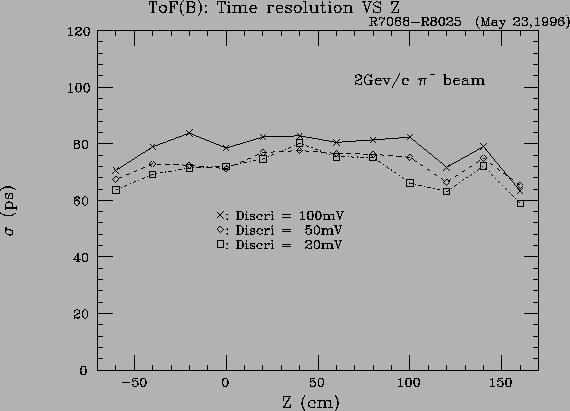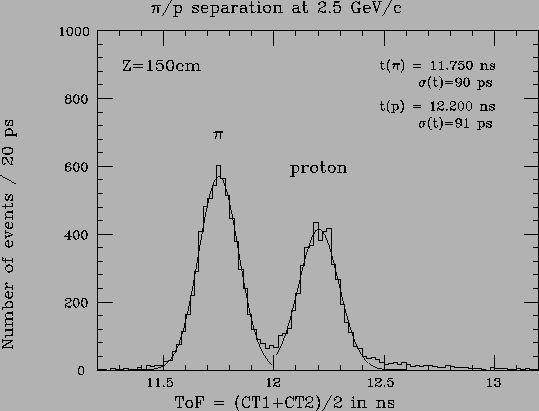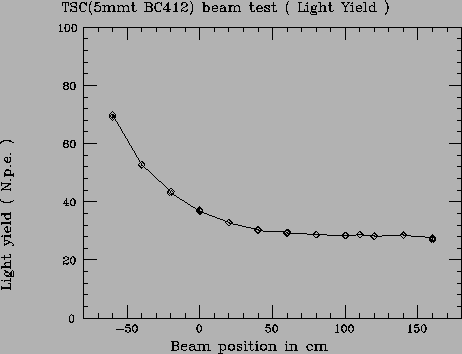



Next: Performance
Up: Time-of-Flight Counters, TOF
Previous: Readout electronics
Contents
A TOF module built in accordance with the final design was assembled
and tested using the  2 test beam line of KEK-PS. The test counter
was set on a movable stage that enabled the position and incident
angle of the beam on the counter to vary simultaneously so that the
geometry of the Belle TOF detector was reproduced.
2 test beam line of KEK-PS. The test counter
was set on a movable stage that enabled the position and incident
angle of the beam on the counter to vary simultaneously so that the
geometry of the Belle TOF detector was reproduced.
Figure ![[*]](./icons/crossref.png) shows the TOF time resolution as a
function of beam position. A time-walk correction was applied at each
position and the start-counter time-jitter of 35 ps was subtracted in
quadrature. An intrinsic time resolution of approximately 80 ps was
obtained over the whole counter. In the Belle experiment we expect
some additional contributions to the time resolution:
shows the TOF time resolution as a
function of beam position. A time-walk correction was applied at each
position and the start-counter time-jitter of 35 ps was subtracted in
quadrature. An intrinsic time resolution of approximately 80 ps was
obtained over the whole counter. In the Belle experiment we expect
some additional contributions to the time resolution:
- a 10 % degradation of the intrinsic resolution caused by the
1.5 T magnetic field as was observed in a beam test of a same-size TOF
counter with a similar fine-mesh PMT,
- a 20 ps contribution due to the 4 mm beam bunch length and
jitter in the RF signal used as the reference time, and
- a 20 ps contribution from time stretcher readout electronics.
Figure:
Time resolution of a Belle TOF module as a function of hit position.
 |
Including these errors in quadrature gives an expected overall time
resolution that meets the Belle design goal of 100 ps.
Figure ![[*]](./icons/crossref.png) shows time-of-flight distributions
for
shows time-of-flight distributions
for  and protons at 2.5 GeV/c which indicate 5
and protons at 2.5 GeV/c which indicate 5 separation of
separation of  /p at 2.5 GeV/c for the beam at a forward region.
This implies approximately 3
/p at 2.5 GeV/c for the beam at a forward region.
This implies approximately 3
 /K separation at 1.25
GeV/c. A tail at later times is attributed to a gain saturation of the
PMT at high signal rates. A rate of minimum ionizing particles on a
whole TOF counter was observed to be about 14 kHz during the test with
a positive beam. At this rate and with a PMT high voltage of 1500 V,
the average anode current was about 10
/K separation at 1.25
GeV/c. A tail at later times is attributed to a gain saturation of the
PMT at high signal rates. A rate of minimum ionizing particles on a
whole TOF counter was observed to be about 14 kHz during the test with
a positive beam. At this rate and with a PMT high voltage of 1500 V,
the average anode current was about 10  A of a total base current
of 60
A of a total base current
of 60  A. In order to minimize the saturation, the ratio of anode
to base currents should be kept below 10 %. With the present IR and
beam pipe design and assuming a PMT gain of
A. In order to minimize the saturation, the ratio of anode
to base currents should be kept below 10 %. With the present IR and
beam pipe design and assuming a PMT gain of  , a Monte
Carlo simulation predicts an anode current of 2.4
, a Monte
Carlo simulation predicts an anode current of 2.4  A. This
indicates that the beam test conditions described above were much
severer than those expected in the Belle environment. In order to
guarantee a further safety margin under high beam background
conditions, the nominal base current was increased to 300
A. This
indicates that the beam test conditions described above were much
severer than those expected in the Belle environment. In order to
guarantee a further safety margin under high beam background
conditions, the nominal base current was increased to 300  A in
the final design.
A in
the final design.
Figure:
 separation at 2.5 GeV/c.
separation at 2.5 GeV/c.
 |
Figure ![[*]](./icons/crossref.png) shows the effective light yield seen by
a TSC PMT as a function of beam position. A minimum ionizing track
produces more than 25 photoelectrons over the whole counter. This
ensures a high efficiency of 98 % for TOF trigger even at a nominal
discrimination level of 0.5 mips.
shows the effective light yield seen by
a TSC PMT as a function of beam position. A minimum ionizing track
produces more than 25 photoelectrons over the whole counter. This
ensures a high efficiency of 98 % for TOF trigger even at a nominal
discrimination level of 0.5 mips.
Figure:
Light yield of a TSC counter as a function of hit position.
 |




Next: Performance
Up: Time-of-Flight Counters, TOF
Previous: Readout electronics
Contents
Samo Stanic
2001-06-02
